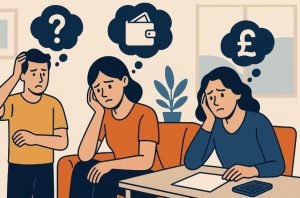Imagine checking your post one morning and finding an official-looking letter from the Department for Work and Pensions (DWP). The letter tells you that your current benefits will soon stop, and you must apply for something called Universal Credit, or risk losing your payments altogether.
For thousands of people across the UK, this is not just a hypothetical scenario. This is the reality unfolding as part of the DWP’s major shift to migrate claimants of four legacy benefits onto Universal Credit.
While the Universal Credit and Personal Independence Bill dominates political discussions, the managed migration process, underway since May 2022, is transforming the benefits landscape quietly but significantly. By March 2026, legacy benefits will be a thing of the past, and every claimant will need to understand and navigate the Universal Credit system.
This blog aims to break down what’s happening, why it matters, and what every claimant should know and do to avoid losing vital support.
What Is the DWP Migration to Universal Credit?

The Department for Work and Pensions introduced Universal Credit (UC) as a means-tested benefit to simplify the welfare system by replacing six so-called legacy benefits:
- Income-related Employment and Support Allowance (ESA)
- Income-based Jobseeker’s Allowance (JSA)
- Income Support (IS)
- Housing Benefit (HB)
- Working Tax Credit (WTC)
- Child Tax Credit (CTC)
By 2018, new claimants were automatically put on Universal Credit, but people already receiving legacy benefits continued under the old system. The plan now is to bring all claimants under the UC umbrella.
This shift is part of a managed migration process, set out in the DWP’s Completing the Move to UC policy and reinforced by research in 2024 and 2025. The goal: to send out migration notices to all remaining claimants by December 2025 and close down all legacy benefit systems by March 2026.
While Working Tax Credit and Child Tax Credit claimants have mostly been moved already, the focus is now on the remaining four legacy benefits. These include those receiving income-related ESA, Income Support, income-based JSA, and Housing Benefit.
Which Four Legacy Benefits Are Affected?
The claimants currently targeted for migration include those receiving:
- Income-related Employment and Support Allowance (ESA)
- Income Support
- Income-based Jobseeker’s Allowance (JSA)
- Housing Benefit
It’s crucial to note that people claiming Working Tax Credit and Child Tax Credit have already transitioned as part of earlier migration phases.
This focus on four remaining benefits means thousands of households across England, Wales, and Scotland will receive letters if they have not already. These migration notice letters inform them of their need to apply for Universal Credit to continue receiving financial assistance.
HMRC has also provided guidance on separate matters like the 3-week tax refund rule, ensuring claimants understand timings for tax-related payments. However, the main urgency for benefit recipients now is the DWP’s migration process.
Why Are Claimants Receiving DWP Letters Now?
Since May 2022, the DWP has followed a phased approach, gradually inviting households to transition to Universal Credit. Initial groups included those on Tax Credits, followed by income-related ESA with Child Tax Credit, Income Support, Housing Benefit, and income-based JSA.
The letters, known as migration notices, are crucial because migration is not automatic. Simply put, if you don’t apply for Universal Credit after receiving a migration notice, your current benefits will end.
These letters set a personal deadline, the final date by which you can apply and still qualify for transitional protection. This safeguard ensures you receive the same amount as under your previous benefits, even if the UC assessment would ordinarily entitle you to less.
You can apply for Universal Credit before you get the letter or after the deadline, but without transitional protection, you may lose out financially.
What’s Inside the Migration Notice Letter?

The migration notice letter contains essential details, including:
- Your personal deadline date to apply for Universal Credit.
- How to apply online or by phone.
- Transitional protection eligibility.
- Contact details for support, including the Universal Credit Migration Notice Helpline at 0800 169 0328.
Transitional Protection Explained
Transitional protection is vital. It ensures you don’t receive less under Universal Credit than you did from your legacy benefits, at least initially.
For example, if you were receiving £140.55 per week on ESA but under UC you’d be entitled to £100, transitional protection provides an additional £40.55 to bridge the gap.
This safeguard is only available if you apply by your specified deadline. Miss that, and you apply under the normal Universal Credit rules, potentially at a lower amount.
How Does Transitional Protection Work?
To help you understand, here’s a comparison table showing typical adjustments under transitional protection.
| Benefit | Legacy Weekly Amount | Universal Credit Amount | Transitional Protection Top-Up |
| Employment and Support Allowance (ESA) | £140.55 | £100 | £40.55 |
| Income Support | £120 | £95 | £25 |
| Jobseeker’s Allowance (JSA) | £114 | £90 | £24 |
Transitional protection is designed to prevent financial loss but does not last forever. Future changes in circumstances, such as a change in household makeup or earnings, may affect this top-up.
Key Points to Remember
- You must apply before your deadline.
- Contact the helpline if you cannot apply on time.
- Keep your details and documentation ready for the claim process.
What Should You Do If You Can’t Apply Before the Deadline?

Life is unpredictable. If you face personal challenges, caring responsibilities, health issues, or other barriers, you must contact the Universal Credit Migration Notice Helpline.
The DWP offers flexibility, including deadline extensions, if you have valid reasons. Many people have successfully secured extensions by explaining their circumstances, whether it’s difficulty gathering paperwork or navigating the online system.
The helpline number is 0800 169 0328. Calling before your deadline gives you the best chance to maintain your financial support without disruption.
How Do You Apply for Universal Credit?
There are two main ways to apply:
Online Application
You can set up a Universal Credit account online. Once created, you must complete the application within 28 days. Digitally confident claimants often manage this smoothly, but those unfamiliar with online forms may need support.
Phone Application
Alternatively, you can apply by calling the Migration Notice Helpline. Some claimants prefer this route, especially if they encounter problems online or have accessibility needs.
For those who struggle with digital processes, the helpline has proven to be a lifeline, although reports suggest it can sometimes be busy, so persistence is needed.
What Changes Are Coming to Universal Credit in 2026?
Looking ahead, the forthcoming Universal Credit and Personal Independence Bill will introduce several significant changes, notably:
- Cutting and freezing the health component rate for new claimants from April 2026.
- Protecting existing claimants who transitioned before the change, ensuring they keep their current rate.
This means that anyone already on Universal Credit before April 2026 will be shielded from the reductions, an important point for those weighing when to apply.
The government’s timeline to send all migration notices by December 2025 and wrap up legacy benefits by March 2026 is aligned with this shift, offering transitional safeguards to those already moved.
What Are Common Concerns Claimants Have?

Based on DWP research and interviews conducted across England, Wales, and Scotland, claimants share several key concerns:
- Fear of payment gaps during the transition.
- Confusion over monthly payments after years of fortnightly legacy benefit payments.
- Worries about managing rent payments, especially among those new to handling this themselves.
- Digital barriers, especially among claimants without internet access or digital skills.
- Concerns about eligibility rules and whether they will still qualify for support.
Emotional Impact
For many, receiving the migration notice triggers anxiety, especially among those with existing health conditions or mental health challenges. Some participants described putting the letter aside due to stress, hoping for direct DWP support or help from charities.
How Can Claimants Get Help or Advice?
Support is available, and claimants are encouraged to use it. Common resources include:
- Citizens Advice
- Disability Rights UK
- Housing Officers and local support organisations
- Jobcentre Plus advisors
These organisations can help with:
- Understanding the migration process.
- Preparing necessary documentation.
- Navigating the online or phone application process.
- Addressing financial concerns.
The DWP has also enhanced support by offering outbound calls and, in some cases, home visits for claimants needing additional assistance.
Conclusion
The migration to Universal Credit marks a profound shift in the UK’s benefits landscape. For claimants of four key legacy benefits, Income-related ESA, Income Support, Income-based JSA, and Housing Benefit, understanding what the DWP’s migration letters mean is essential to maintaining financial security.
From transitional protection safeguards to the looming 2026 changes, the stakes are high. But with the right knowledge, timely action, and available support, claimants can navigate this change successfully.
If you or someone you know has received a migration notice, don’t wait. Check the deadline, gather the necessary information, and apply, or reach out for help if you need it.
The DWP’s goal is to complete this migration by March 2026, but the responsibility to secure one’s benefits rests with each individual.
FAQs
What happens if I miss my Universal Credit migration deadline?
If you miss your deadline, your legacy benefits will stop, and you will lose eligibility for transitional protection, potentially receiving a lower amount.
Will I lose money when I switch to Universal Credit?
With transitional protection, you should initially receive the same amount, but over time, changes in circumstances could affect your payment.
Can I apply for Universal Credit before getting a DWP letter?
Yes, but if you apply before receiving a migration notice, you won’t be eligible for transitional protection.
How long does the Universal Credit application take?
Once you create an online account, you must complete the application within 28 days. Phone applications can vary depending on call wait times.
Is transitional protection permanent?
No, it lasts until a significant change in your circumstances, such as household changes or income increases.
Will the 2026 benefit changes affect current claimants?
No, existing claimants before April 2026 will be protected from the health component cuts.
Who can I contact for help with Universal Credit migration?
You can contact the Universal Credit Migration Notice Helpline at 0800 169 0328 or reach out to organisations like Citizens Advice or local support services.









